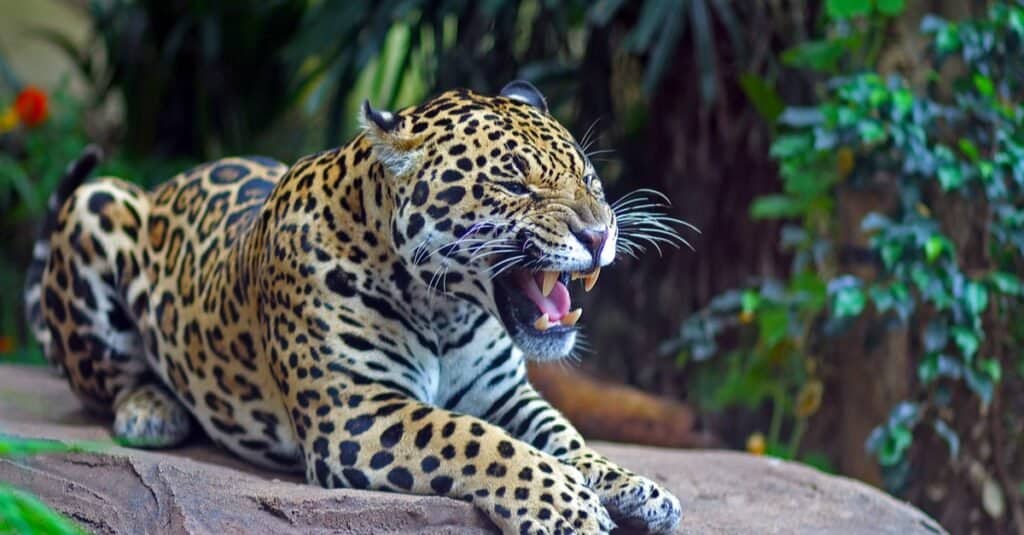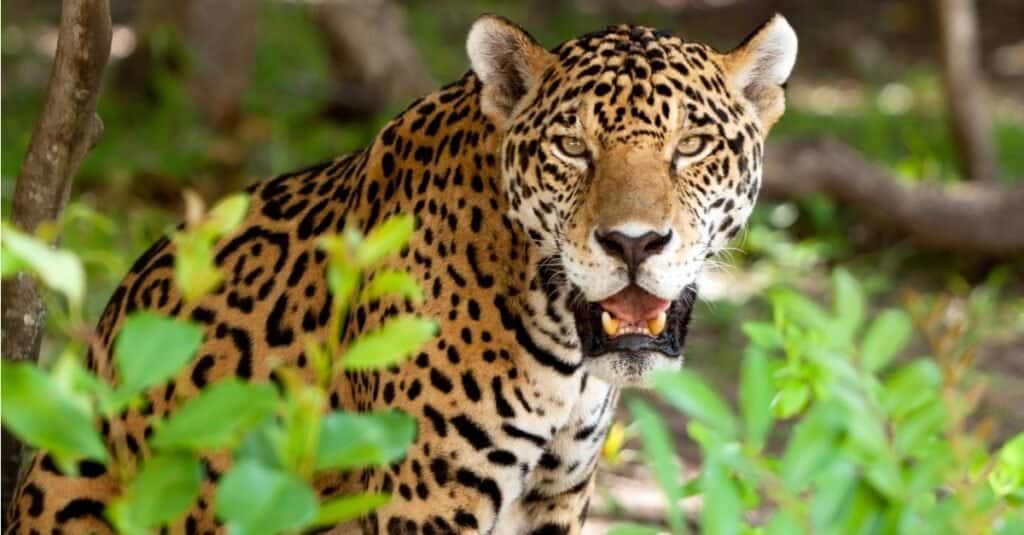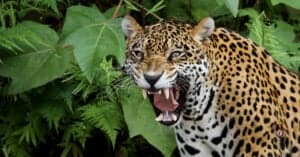Discover The Largest Jaguar Ever
Tigers and lions are some of the largest big cats in the world, but Jaguars are also capable of reaching massive sizes. Compared with your average house cat, jaguars are much larger. They are painted with an iconic pattern on their coat. Some people might confuse them with leopards, but the two are actually different species.
Learning about jaguars is important since they are a near-threatened species whose population continues to decline. Most big cats are experiencing population decline, and some are even close to becoming extinct. Lions and tigers are the only cat species larger than the jaguar.
Compared with other members of the Felidae family, jaguars are one of the biggest species of big cats, but how large can they actually get? In this article, you will learn about jaguars, their size, the biggest jaguar on record, and how large they have been able to get. Let’s learn about this big spotted cat.
The Biggest Jaguar Ever

GoWildPhotography/Shutterstock.com
The largest jaguar on record weighed 328 pounds!
Jaguars are the third-largest cat in the world and are only behind lions and tigers. On record, the largest jaguar ever was a male that weighed 149 kg (which is 328 lbs) and was the subspecies Panthera onca alustris. This subspecies is the largest of all jaguar types and inhabits regions within South America like Brazil. This subspecies of the jaguar is known to reach around 300 lbs.
Not all jaguars will get up to this size, as it will vary depending on the cat. On average jaguars will weigh between 126 to 300 lbs. (57 to 113kg). Their body length varies between 3.7 to 6.1 feet (12 to 185cm). Males are larger than females, and it is believed some can grow as long as 9 feet (274cm). This large size helps them catch prey, and defend themselves from predators like caimans.
What to Know About Jaguars
Jaguars live in South America and Mexico. In the United States, they are sometimes spotted in far southwestern regions of Arizona. Jaguars in the U.S are rare but may wander into the state from Mexico. Forests are their preferred habitat. It is rare to find a jaguar in open fields, as they use large trees to sleep and avoid heat. They prefer areas near water sources like a river. This species is solitary and occasionally comes together to mate for a brief period.
Jaguars are muscular with large paws and skulls. Their fur is a golden yellow and is covered in spots that are unique to each jaguar. The spots on their head and legs are solid, but along their body, it turns into a broken spot pattern called a rosette. Some jaguars can be all black, but this is rare.
The diet of a jaguar is made up of the animals they hunt in the wild. Over 89 species of animals have been recorded to be hunted by jaguars. Jaguars eat almost anything they come across. They use their large size and strong jaws to kill prey by attacking the neck. It is rare for jaguars to attack humans, as they try their best to avoid people.
Types Of Jaguars

iStock.com/Patryk_Kosmider
There are around nine different jaguar subspecies historically classified. Some studies show that there is no difference between the subspecies genetically, but the subspecies show differences by the range they inhabit. Here are the nine subspecies of the jaguar.
- Panthera onca onca (East Brazilian Jaguar)
- Panthera onca arizonensis (Arizona Jaguar)
- Panthera onca centralis (Central American Jaguar)
- Panthera onca goldmani (Yucatan Peninsula Jaguar)
- Panthera onca hernandesii (West Mexican Jaguar)
- Panthera onca palustris (South American Jaguar)
- Panthera onca paraguensis (Paraguay Jaguar)
- Panthera onca peruviana (Peruvian Jaguar)
- Panthera onca veraecrucis (Northeastern jaguar)
Most jaguar subspecies look similar and are the same when analyzed genetically. The largest of the subspecies is the South American Jaguar (Panthera onca palustris). Other differences between jaguars species are minor, and scientists continue to debate how to classify the species.
Jaguars Compared With Other Big Cats

A-Z-Animals.com
Leopards are the closest species to jaguars, and it is easy to confuse the two. Leopards are the smaller of the two species. Male leopards are larger than females and weigh around 80 to 165 lbs. They reach an average of 28 inches at the shoulders. Leopards and jaguars are not the same species, and one easy way to differentiate the two is their location. Jaguars are only found in South and Central America. Leopards live in Asia and Africa, and we’ll never cross paths with a jaguar in the wild.
Jaguars are the third-largest cat species in the world. Tigers and lions are both bigger than the Jaguar, but each species size will vary. Male cats are larger than females in the top 3 species. Female lions are around the same size as male jaguars. Since they are similar in size cross-breeding between the two species has occurred in captivity. Hybrids between jaguars, leopards, tigers, and lions are possible, but almost never happen in nature. Jaglions are a hybrid between a female lion and a male leopard. Cross Breeding big cats are done to create giant hybrids like the Liger, or unique breeds like a lion with jaguar-like spots on it.
Why are Jaguars Endangered
Similar to other big cats, jaguars have been experiencing a decline in their population. They are classified as near threatened and have been extradited within many regions of their range. Habitat loss, illegal hunting, and the decline of available prey in the wild are reasons why their numbers have been dropping. Jaguars were once found in the U.S commonly living in states like Arizona, California, New Mexico, Texas, and Louisiana.
Sightings in these states sometimes still occur, and it is estimated a population of around 100 is still present near the northern end of the jaguar’s range. Humans are the main reasons jaguars have been pushed out of their homes in the U.S and are on the decline as a species. The best way to protect these cats is with habitat protection and limiting negative contact with humans. Hope still exists for jaguars, as they have a population of around 60,000 remaining cats. However, their population is splintered and across a vast range that extends from Northern Mexico to the borders of Argentina in South America.
More from A-Z Animals
Tigers and lions are some of the largest big cats in the world, but Jaguars are also capable of reaching massive sizes. Compared with your average house cat, jaguars are much larger. They are painted with an iconic pattern on their coat. Some people might confuse them with leopards, but the two are actually different species.
Learning about jaguars is important since they are a near-threatened species whose population continues to decline. Most big cats are experiencing population decline, and some are even close to becoming extinct. Lions and tigers are the only cat species larger than the jaguar.
Compared with other members of the Felidae family, jaguars are one of the biggest species of big cats, but how large can they actually get? In this article, you will learn about jaguars, their size, the biggest jaguar on record, and how large they have been able to get. Let’s learn about this big spotted cat.
The Biggest Jaguar Ever

GoWildPhotography/Shutterstock.com
The largest jaguar on record weighed 328 pounds!
Jaguars are the third-largest cat in the world and are only behind lions and tigers. On record, the largest jaguar ever was a male that weighed 149 kg (which is 328 lbs) and was the subspecies Panthera onca alustris. This subspecies is the largest of all jaguar types and inhabits regions within South America like Brazil. This subspecies of the jaguar is known to reach around 300 lbs.
Not all jaguars will get up to this size, as it will vary depending on the cat. On average jaguars will weigh between 126 to 300 lbs. (57 to 113kg). Their body length varies between 3.7 to 6.1 feet (12 to 185cm). Males are larger than females, and it is believed some can grow as long as 9 feet (274cm). This large size helps them catch prey, and defend themselves from predators like caimans.
What to Know About Jaguars
Jaguars live in South America and Mexico. In the United States, they are sometimes spotted in far southwestern regions of Arizona. Jaguars in the U.S are rare but may wander into the state from Mexico. Forests are their preferred habitat. It is rare to find a jaguar in open fields, as they use large trees to sleep and avoid heat. They prefer areas near water sources like a river. This species is solitary and occasionally comes together to mate for a brief period.
Jaguars are muscular with large paws and skulls. Their fur is a golden yellow and is covered in spots that are unique to each jaguar. The spots on their head and legs are solid, but along their body, it turns into a broken spot pattern called a rosette. Some jaguars can be all black, but this is rare.
The diet of a jaguar is made up of the animals they hunt in the wild. Over 89 species of animals have been recorded to be hunted by jaguars. Jaguars eat almost anything they come across. They use their large size and strong jaws to kill prey by attacking the neck. It is rare for jaguars to attack humans, as they try their best to avoid people.
Types Of Jaguars

iStock.com/Patryk_Kosmider
There are around nine different jaguar subspecies historically classified. Some studies show that there is no difference between the subspecies genetically, but the subspecies show differences by the range they inhabit. Here are the nine subspecies of the jaguar.
- Panthera onca onca (East Brazilian Jaguar)
- Panthera onca arizonensis (Arizona Jaguar)
- Panthera onca centralis (Central American Jaguar)
- Panthera onca goldmani (Yucatan Peninsula Jaguar)
- Panthera onca hernandesii (West Mexican Jaguar)
- Panthera onca palustris (South American Jaguar)
- Panthera onca paraguensis (Paraguay Jaguar)
- Panthera onca peruviana (Peruvian Jaguar)
- Panthera onca veraecrucis (Northeastern jaguar)
Most jaguar subspecies look similar and are the same when analyzed genetically. The largest of the subspecies is the South American Jaguar (Panthera onca palustris). Other differences between jaguars species are minor, and scientists continue to debate how to classify the species.
Jaguars Compared With Other Big Cats

A-Z-Animals.com
Leopards are the closest species to jaguars, and it is easy to confuse the two. Leopards are the smaller of the two species. Male leopards are larger than females and weigh around 80 to 165 lbs. They reach an average of 28 inches at the shoulders. Leopards and jaguars are not the same species, and one easy way to differentiate the two is their location. Jaguars are only found in South and Central America. Leopards live in Asia and Africa, and we’ll never cross paths with a jaguar in the wild.
Jaguars are the third-largest cat species in the world. Tigers and lions are both bigger than the Jaguar, but each species size will vary. Male cats are larger than females in the top 3 species. Female lions are around the same size as male jaguars. Since they are similar in size cross-breeding between the two species has occurred in captivity. Hybrids between jaguars, leopards, tigers, and lions are possible, but almost never happen in nature. Jaglions are a hybrid between a female lion and a male leopard. Cross Breeding big cats are done to create giant hybrids like the Liger, or unique breeds like a lion with jaguar-like spots on it.
Why are Jaguars Endangered
Similar to other big cats, jaguars have been experiencing a decline in their population. They are classified as near threatened and have been extradited within many regions of their range. Habitat loss, illegal hunting, and the decline of available prey in the wild are reasons why their numbers have been dropping. Jaguars were once found in the U.S commonly living in states like Arizona, California, New Mexico, Texas, and Louisiana.
Sightings in these states sometimes still occur, and it is estimated a population of around 100 is still present near the northern end of the jaguar’s range. Humans are the main reasons jaguars have been pushed out of their homes in the U.S and are on the decline as a species. The best way to protect these cats is with habitat protection and limiting negative contact with humans. Hope still exists for jaguars, as they have a population of around 60,000 remaining cats. However, their population is splintered and across a vast range that extends from Northern Mexico to the borders of Argentina in South America.






